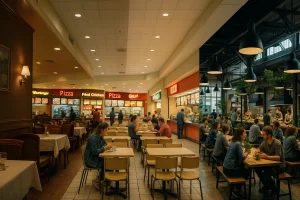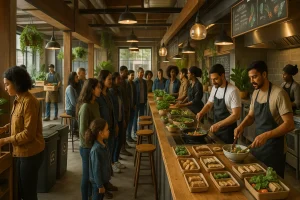In the past decade, the dining scene has undergone a transformation that goes far beyond what’s on the plate. Gone are the days when food courts were simply a convenient pit stop during a shopping trip.
Today, food halls have emerged as cultural and social hubs curated spaces where gastronomy, community, and experience converge. From sizzling wings to premium wagyu beef, these venues have become destinations in their own right, redefining how people eat, connect, and spend their leisure time.
The Evolution of Dining Spaces

Food has always brought people together, but how and where we eat has evolved dramatically. Traditional restaurants once reigned supreme, offering focused menus and distinct atmospheres.
Food courts, by contrast, were all about efficiency fast, affordable meals designed for shoppers on the go. But the food hall is a different story altogether.
Blending the diversity of a food court with the sophistication of fine dining, food halls bring together a curated mix of vendors, each specialising in a distinct cuisine or concept.
The result is a vibrant tapestry of flavours and cultures under one roof. Unlike traditional restaurants, food halls thrive on variety and social energy diners can grab a craft beer from one stall, share bao buns from another, and finish off with a small-batch dessert, all while seated in a shared, open setting that encourages connection.
This communal spirit has resonated particularly well with younger generations who value experiences over possessions. Food halls are not just about eating; they are about being immersing in atmosphere, trying new flavours, and sharing the experience across social circles and social media alike.
The Allure of Culinary Diversity
At the heart of the food hall revolution lies diversity. Walk into any bustling food hall and you’ll find the world on a plate: Japanese ramen steaming next to smoky American barbecue, artisanal pizza sharing space with Thai street food.
This global mix caters to increasingly adventurous palates while offering something for everyone from health-conscious eaters to comfort food lovers.
This diversity is also an answer to the modern diner’s desire for flexibility. No longer confined to a single cuisine or course, visitors can mix and match their meals, exploring new tastes without the commitment of a full sit-down dinner. Whether you’re craving fiery chicken wings, fresh sushi, or a gourmet burger, a food hall allows you to satisfy every craving in one outing.
One standout example of this new dining experience can be found in Manchester’s iconic Trafford Centre, where global chains and local favourites coexist harmoniously.
Here, food lovers can explore everything from traditional comfort dishes to modern culinary experiments. For those who like their food bold and flavourful, the https://traffordcentre.co.uk/shop/wing-stop offers a perfect snapshot of the food hall’s appeal quick, casual, and irresistibly tasty.
Wingstop, famous for its mouth-watering wings and signature sauces, fits seamlessly into the social energy of a modern food hall. It represents the perfect bridge between fast food and flavour-driven dining a place where quality and convenience meet.
Social Dining and Shared Experiences
What makes food halls more than just a place to eat is their emphasis on shared experience. These spaces are designed for social interaction, with open layouts that encourage mingling, communal tables that invite conversation, and often, live entertainment or cultural events that enhance the atmosphere.
It’s dining as theatre an immersive experience where food is only one part of the story. Friends meet after work for cocktails and street-style snacks; families gather for casual weekend lunches; couples explore new cuisines together. The variety of offerings allows groups with different tastes to share a single meal without compromise.
Moreover, food halls have become prime spaces for social discovery. They host pop-up events, cooking demos, and collaborations with local chefs, adding an element of surprise to each visit. The blend of aromas, sounds, and sights creates an energy that feels almost festival-like a sensory celebration of food and community.
Supporting Local Talent and Sustainable Dining

Beyond their social appeal, food halls have also played a vital role in reshaping the local food ecosystem. By providing opportunities for independent chefs and small food entrepreneurs to showcase their craft without the heavy overhead of a standalone restaurant, food halls have become incubators for culinary innovation.
Many chefs use food halls as launchpads to test new concepts, menus, and ideas, often with a focus on sustainability and locality. The ability to interact directly with diners fosters a feedback loop that helps these small businesses thrive. For consumers, this means access to authentic, freshly prepared meals that reflect both local produce and global influences.
In addition, the communal nature of food halls lends itself naturally to more sustainable practices shared resources, reduced food waste, and collective efforts toward greener operations. From eco-friendly packaging to waste reduction initiatives, these dining spaces are leading the way toward a more responsible food culture.
The Role of Design and Atmosphere
The modern food hall is as much about ambiance as it is about food. Industrial-chic interiors, open kitchens, ambient lighting, and thoughtful seating arrangements all contribute to an environment that’s dynamic yet comfortable.
It’s a space where solo diners can enjoy a quiet lunch at the counter while groups gather for lively conversation at long communal tables.
Design plays a key role in cultivating the “social hotspot” identity of these venues. The layout encourages exploration diners move from one vendor to another, discovering new options as they go.
Many food halls also incorporate cultural or artistic elements, such as local artwork, live music, or design installations, creating a multi-sensory experience that keeps people coming back for more.
Conclusion
The rise of food halls marks a shift in how we experience dining from consumption to connection, from quick bites to meaningful moments. They embody the best of both worlds: the excitement of street food culture and the quality of gourmet dining, all wrapped in a social, inclusive atmosphere.
Whether you’re sampling wagyu sliders, vegan bowls, or spicy wings, food halls remind us that eating is about more than satisfying hunger it’s about savouring life together. In these vibrant spaces where flavours meet friendship, dining becomes not just an activity but an experience worth sharing.




